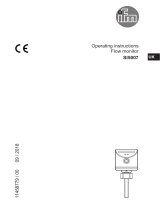
3
UK
6�3 Ground ��������������������������������������������������������������������������������������������������������28
6�4 Installation in pipes �������������������������������������������������������������������������������������29
7 Electrical connection �����������������������������������������������������������������������������������������30
8 Operating and display elements �����������������������������������������������������������������������32
9 Menu �����������������������������������������������������������������������������������������������������������������33
9�1 Process value display (RUN) ����������������������������������������������������������������������33
9�2 Main menu ��������������������������������������������������������������������������������������������������34
9�3 Extended functions EF �������������������������������������������������������������������������������35
9�4 Submenu OUT1 and OUT2 ������������������������������������������������������������������������36
9�5 Submenu CFG and TOTL ���������������������������������������������������������������������������39
9�6 Submenu MEM and DIS �����������������������������������������������������������������������������41
9�7 Submenu COLR and SIM ���������������������������������������������������������������������������43
10 Set-up �������������������������������������������������������������������������������������������������������������45
11 Parameter setting ��������������������������������������������������������������������������������������������45
11�1 Parameter setting in general ���������������������������������������������������������������������46
11�1�1 Select submenu �������������������������������������������������������������������������������46
11�1�2 Change to the process value display (RUN mode) ��������������������������46
11�1�3 Locking / unlocking ��������������������������������������������������������������������������46
11�1�4 Timeout ��������������������������������������������������������������������������������������������47
11�2 Settings for volumetric flow monitoring �����������������������������������������������������47
11�2�1 Limit monitoring OUT1 or OUT2 / hysteresis function ���������������������47
11�2�2 Limit monitoring OUT1 or OUT2 / window function �������������������������47
11�2�3 Switching signal volumetric flow direction OUT1 or OUT2 ��������������47
11�2�4 Frequency signal volumetric flow OUT1 ������������������������������������������48
11�2�5 Analogue signal volumetric flow OUT2 ��������������������������������������������48
11�3 Settings for consumed quantity monitoring �����������������������������������������������48
11�3�1 Metering method of the totalisers ���������������������������������������������������48
11�3�2 Quantity monitoring via pulse output OUT1 �������������������������������������48
11�3�3 Quantity monitoring via the preset counter OUT1 ���������������������������49
11�3�4 Manual meter reset ��������������������������������������������������������������������������49
11�3�5 Time-controlled meter reset �������������������������������������������������������������49
11�3�6 Deactivate meter reset ���������������������������������������������������������������������49
11�3�7 Meter reset via external signal ���������������������������������������������������������49
11�3�8 Read consumption values ���������������������������������������������������������������50
11�4 Settings for temperature monitoring ����������������������������������������������������������50























